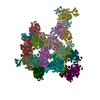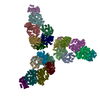+ Open data
Open data
- Basic information
Basic information
| Entry | Database: PDB / ID: 7k1y | ||||||
|---|---|---|---|---|---|---|---|
| Title | PIKfyve/Fig4/Vac14 complex centered on Vac14 - map1 | ||||||
 Components Components | Vac14 | ||||||
 Keywords Keywords | LIPID BINDING PROTEIN / Lipid kinase / Lipid phosphatase / protein complex | ||||||
| Biological species |  Homo sapiens (human) Homo sapiens (human) | ||||||
| Method | ELECTRON MICROSCOPY / single particle reconstruction / cryo EM / Resolution: 5.25 Å | ||||||
 Authors Authors | Lees, J.A. / Reinisch, K.M. / Li, P. | ||||||
| Funding support |  United States, 1items United States, 1items
| ||||||
 Citation Citation |  Journal: Mol Cell / Year: 2020 Journal: Mol Cell / Year: 2020Title: Insights into Lysosomal PI(3,5)P Homeostasis from a Structural-Biochemical Analysis of the PIKfyve Lipid Kinase Complex. Authors: Joshua A Lees / PeiQi Li / Nikit Kumar / Lois S Weisman / Karin M Reinisch /  Abstract: The phosphoinositide PI(3,5)P, generated exclusively by the PIKfyve lipid kinase complex, is key for lysosomal biology. Here, we explore how PI(3,5)P levels within cells are regulated. We find the ...The phosphoinositide PI(3,5)P, generated exclusively by the PIKfyve lipid kinase complex, is key for lysosomal biology. Here, we explore how PI(3,5)P levels within cells are regulated. We find the PIKfyve complex comprises five copies of the scaffolding protein Vac14 and one copy each of the lipid kinase PIKfyve, generating PI(3,5)P from PI3P and the lipid phosphatase Fig4, reversing the reaction. Fig4 is active as a lipid phosphatase in the ternary complex, whereas PIKfyve within the complex cannot access membrane-incorporated phosphoinositides due to steric constraints. We find further that the phosphoinositide-directed activities of both PIKfyve and Fig4 are regulated by protein-directed activities within the complex. PIKfyve autophosphorylation represses its lipid kinase activity and stimulates Fig4 lipid phosphatase activity. Further, Fig4 is also a protein phosphatase acting on PIKfyve to stimulate its lipid kinase activity, explaining why catalytically active Fig4 is required for maximal PI(3,5)P production by PIKfyve in vivo. | ||||||
| History |
|
- Structure visualization
Structure visualization
| Movie |
 Movie viewer Movie viewer |
|---|---|
| Structure viewer | Molecule:  Molmil Molmil Jmol/JSmol Jmol/JSmol |
- Downloads & links
Downloads & links
- Download
Download
| PDBx/mmCIF format |  7k1y.cif.gz 7k1y.cif.gz | 328.5 KB | Display |  PDBx/mmCIF format PDBx/mmCIF format |
|---|---|---|---|---|
| PDB format |  pdb7k1y.ent.gz pdb7k1y.ent.gz | 283 KB | Display |  PDB format PDB format |
| PDBx/mmJSON format |  7k1y.json.gz 7k1y.json.gz | Tree view |  PDBx/mmJSON format PDBx/mmJSON format | |
| Others |  Other downloads Other downloads |
-Validation report
| Summary document |  7k1y_validation.pdf.gz 7k1y_validation.pdf.gz | 821.4 KB | Display |  wwPDB validaton report wwPDB validaton report |
|---|---|---|---|---|
| Full document |  7k1y_full_validation.pdf.gz 7k1y_full_validation.pdf.gz | 838.7 KB | Display | |
| Data in XML |  7k1y_validation.xml.gz 7k1y_validation.xml.gz | 33.7 KB | Display | |
| Data in CIF |  7k1y_validation.cif.gz 7k1y_validation.cif.gz | 65.6 KB | Display | |
| Arichive directory |  https://data.pdbj.org/pub/pdb/validation_reports/k1/7k1y https://data.pdbj.org/pub/pdb/validation_reports/k1/7k1y ftp://data.pdbj.org/pub/pdb/validation_reports/k1/7k1y ftp://data.pdbj.org/pub/pdb/validation_reports/k1/7k1y | HTTPS FTP |
-Related structure data
| Related structure data |  22634MC  7k1wC  7k2vC M: map data used to model this data C: citing same article ( |
|---|---|
| Similar structure data | |
| EM raw data |  EMPIAR-10578 (Title: Cryo electron microscopy single particle of PIKfyve lipid kinase complex EMPIAR-10578 (Title: Cryo electron microscopy single particle of PIKfyve lipid kinase complexData size: 920.4 / Data #1: PIKfyve complex [micrographs - multiframe]) |
- Links
Links
- Assembly
Assembly
| Deposited unit | 
|
|---|---|
| 1 |
|
- Components
Components
| #1: Protein | Mass: 45293.883 Da / Num. of mol.: 5 Source method: isolated from a genetically manipulated source Source: (gene. exp.)  Homo sapiens (human) / Cell line (production host): Expi293F / Production host: Homo sapiens (human) / Cell line (production host): Expi293F / Production host:  Homo sapiens (human) Homo sapiens (human)Sequence details | Due to low resolution, only backbone atoms are modeled. The full sequence of the protein is: ...Due to low resolution, only backbone atoms are modeled. The full sequence of the protein is: MNPEKDFAPL | |
|---|
-Experimental details
-Experiment
| Experiment | Method: ELECTRON MICROSCOPY |
|---|---|
| EM experiment | Aggregation state: PARTICLE / 3D reconstruction method: single particle reconstruction |
- Sample preparation
Sample preparation
| Component | Name: PIKfyve/Fig4/Vac14 complex / Type: COMPLEX / Entity ID: all / Source: RECOMBINANT |
|---|---|
| Molecular weight | Value: 4.28 MDa / Experimental value: NO |
| Source (natural) | Organism:  Homo sapiens (human) Homo sapiens (human) |
| Source (recombinant) | Organism:  Homo sapiens (human) / Cell: Expi293F Homo sapiens (human) / Cell: Expi293F |
| Buffer solution | pH: 7.8 |
| Specimen | Embedding applied: NO / Shadowing applied: NO / Staining applied: NO / Vitrification applied: YES |
| Vitrification | Cryogen name: ETHANE |
- Electron microscopy imaging
Electron microscopy imaging
| Experimental equipment |  Model: Titan Krios / Image courtesy: FEI Company |
|---|---|
| Microscopy | Model: FEI TITAN KRIOS |
| Electron gun | Electron source:  FIELD EMISSION GUN / Accelerating voltage: 300 kV / Illumination mode: FLOOD BEAM FIELD EMISSION GUN / Accelerating voltage: 300 kV / Illumination mode: FLOOD BEAM |
| Electron lens | Mode: BRIGHT FIELD / Cs: 2.7 mm |
| Image recording | Electron dose: 58.4 e/Å2 / Film or detector model: GATAN K2 SUMMIT (4k x 4k) |
- Processing
Processing
| CTF correction | Type: NONE |
|---|---|
| 3D reconstruction | Resolution: 5.25 Å / Resolution method: FSC 0.143 CUT-OFF / Num. of particles: 53279 / Symmetry type: POINT |
 Movie
Movie Controller
Controller








 PDBj
PDBj